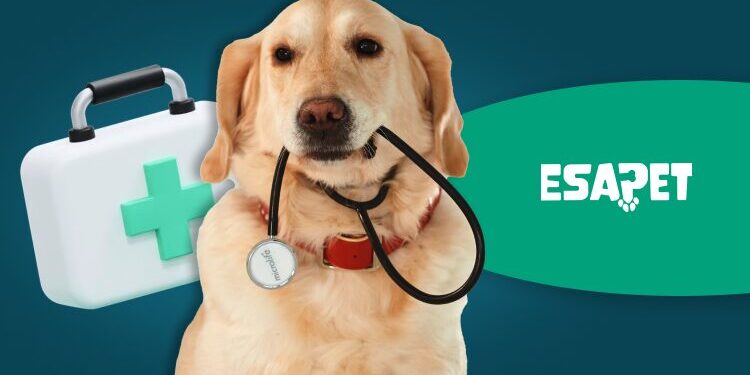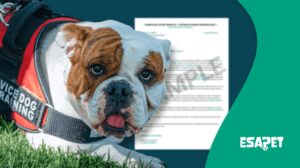Medical Alert Service Dog: Benefits, Training Tips & More (2026 Guide)

ESA Pet is dedicated to helping individuals by certifying their pets as PSDs or ESAs. Our simple three-step process ensures you can gain independence with a service dog or an emotional support animal trained for your needs.
This article will discuss the benefits of medical alert service dogs. It will provide insights into their training methods and how these dogs can assist with daily challenges. Additionally, it will cover legal rights, protections, and more.
What are Medical Alert and Medical Response Dogs?
A medical alert dog is a trained service animal focusing on early detection of medical crises. It senses specific changes in its handler’s body, allowing for preventive actions. This helps manage chronic conditions more effectively.
Medical response dogs assist during and after medical events, providing crucial support. They help when immediate intervention is needed. These dogs ensure timely assistance. They enhance safety for individuals with chronic pain and other medical conditions.
Medical Alert Dogs
Their sensitive canine sense makes medical alert dogs sense impending medical crises. This ability is crucial for individuals with diabetes, epilepsy, and severe allergies. These service animals can detect subtle changes in their handler’s body, often through scent.
The importance of early alerts cannot be overstated. When a medical alert dog detects impending crisis situations, it communicates this to its handler through various methods.
This early warning system enables the handler to take immediate steps to manage their condition. It can include taking medication, eating a snack to raise blood sugar, or finding a safe place to avoid injury.
These dogs use these communication methods like pawing, barking, nudging, and starting to alert their handlers.
Communication methods to alert their handlers:
- Pawing: The dog may gently paw at you to get your attention.
- Barking: A specific bark is used to signal that something is wrong.
- Nudging: The dog uses its nose to nudge you persistently.
- Staring: The dog maintains intense eye contact to indicate urgency.
Roles and Responsibilities:
- Diabetes Alert: Detecting low blood sugar levels and alerting the handler before they become symptomatic.
- Seizure Prediction: Sense and warn about an impending seizure. This gives the handler time to prepare or seek a safe environment.
- Cardiac Alert: Recognizing heart abnormalities or BP changes and alert the handler about a potential heart attack.
- Allergy Alert: Warn about the presence of a severe airborne allergy in the environment. This allows the handler to avoid exposure.
Medical Response Dogs
Medical response dogs are service animals that play a critical role during and after the onset of a medical crisis. They focus on offering immediate assistance once a crisis has begun. These dogs are equipped with the skills to perform life-saving tasks.
These tasks ensure their handlers receive timely help and support. A medical response dog thereby minimizes the impact of the medical episode.
For instance, if you experience a sudden drop in blood sugar levels and are too weak to reach for your glucose tablets, your assistance dog can bring them to you. Similarly, if you have a seizure, your therapy dog can fetch a phone or a pre-programmed medical device to call for help.
Roles and Responsibilities
- Retrieve Medication: The dog brings essential medication to you when needed.
- Seek Help: The dog alerts nearby individuals or emergency services if you are incapacitated.
- Provide Physical Support: The dog assists you in regaining balance or mobility after a medical event.
- Activate Alarms: The dog presses an emergency button to call for help in a crisis.
- Stay with Handler: The dog remains with you during a medical event. This helps to provide comfort and ensure your safety until help arrives.
- Clear Path: The dog can help clear a safe path for you if you need to move during a crisis.
Medical Assistance Dogs
Medical assistance dogs are service animals that combine the roles of both medical alert and medical response dogs. These service animals provide comprehensive support for individuals with a variety of conditions.
The versatility of these dogs makes them crucial for complex and multifaceted medical conditions. Their ability to perform various tasks tailored to individual needs ensures they can provide the most effective support.
This combination of skills enhances your independence and safety. Knowing that your medical needs are monitored and addressed offers peace of mind.
Roles and Responsibilities:
- Diabetes Alert and Response: Monitor blood sugar levels and alert the handler before they become symptomatic. They can also retrieve glucose tablets or other necessary items.
- Seizure Prediction and Response: Sense and warn about an impending seizure. This gives the handler time to prepare. They also provide support during and after the seizure.
- Cardiac Alert and Response: Detect abnormal heart rhythms or blood pressure changes and alert the handler. They can also fetch medication or seek help if a cardiac event occurs.
- Allergy Alert and Response: Warn about allergens in the environment. They assist in taking preventive measures or seeking help if an allergic reaction occurs.
- Asthma Alert and Response: Detect early signs of respiratory distress and alert the handler. They can also retrieve inhalers or other necessary medication.
- Migraine Alert and Response: Sense the onset of a migraine and alert the handler. This allows them to take medication or find a safe place to rest.
Health Conditions Requiring Medical Alert
Medical alert dogs are essential for individuals with conditions that need constant monitoring. These specially trained service animals provide early warnings and assistance. They significantly enhance the quality of life and safety of their handlers.
Common Conditions
How Dogs Detect Crises
Dogs possess an extraordinary olfactory system. It allows them to detect a wide range of medical conditions. Their sense of smell is significantly more sensitive than that of humans.
This enables them to identify specific volatile organic compounds (VOCs) associated with diseases. Research has shown that dogs can detect unique odors emitted by the human body during medical crises, such as:
- Epileptic seizures
- Fluctuations in blood sugar levels
- Certain cancers
Real-life examples and case studies highlight the remarkable abilities of these dogs. One notable case involves a seizure-alert dog named Zeus. Zeus consistently warned his handler about impending seizures, allowing her to seek safety.
Another example is Hero, who detected his owner’s severe allergic reaction to a hidden allergen. This enabled her to take immediate action and avoid a potentially life-threatening situation.
Process of Acquiring a Medical Alert Service Dog
Acquiring a medical alert service dog involves several steps to ensure the right match. This process is designed to be thorough and supportive. It ensures both the handler and the dog are well-prepared for their roles. Here’s a detailed guide to help you understand each step involved.
Step-by-Step Guide
Obtaining a medical alert service dog may seem difficult. However, breaking it down into manageable steps can make it simple. Here are the steps involved:
Completing the Training Process
The process begins with selecting and enrolling a dog in a training program. This program focuses on teaching the dog specific medical alert tasks. The training process is intensive and time-consuming. It depends on the dog’s learning pace and the complexity of the tasks.
Screening and Eligibility Assessment
Next, you’ll complete a brief pre-screening to determine your eligibility for a PSD letter. This questionnaire covers your disability and your service dog’s behavior and training. This step ensures that a service dog is suitable for your specific situation.
Telehealth Evaluation
A telehealth session with an LMHP is then arranged. During this appointment, you discuss your medical condition, how it impacts your life, and how a service dog can help. The professional assesses your needs and provides a recommendation if a PSD is appropriate for you.
Receiving an Official PSD Letter
Once approved, you will receive your signed PSD letter on the healthcare provider’s letterhead within 24-48 hours. This letter confirms your need for a service animal. It provides legal protections under various laws for public places and housing.
Eligibility for a Service Dog
To qualify, individuals must have a mental illness that significantly impacts their daily life. This includes physical, sensory, psychiatric, intellectual, or other mental disabilities. The disabilities should require continuous monitoring and immediate response.
Common conditions that qualify include diabetes, epilepsy, severe allergies, and cardiovascular diseases. For instance, diabetic alert dogs can detect changes in blood sugar levels. They help in providing timely alerts for preventive actions.
Applicants must also be able to participate in the dog’s training process. This ensures they can handle the dog properly and respond to alerts effectively. A recommendation from a professional is often required to confirm the status of a service dog.
Training a Medical Alert Service Dog
Training a medical alert service dog is a thorough and structured process. It involves teaching the dog to perform specific tasks related to medical alerts. It also ensures the dog has training to behave in various public settings.
Training Regimen
The training for a medical alert service dog begins with basic obedience training. This training ensures that the dog understands commands and behaves well. The dog must pass the General Public Access Test. It assesses the dog’s ability to remain calm and focused in public places.
Afterward, the dog undergoes task training tailored to the handler’s specific needs. This training is repetitive. It involves positive reinforcement to ensure the dog performs its tasks accurately.
Work training is another critical component, involving practical exercises that simulate real-life scenarios. The dog practices responding to medical crises. This involves retrieving medication or seeking help.
Training Methods
Training methods for medical alert dogs vary and can be tailored to specific needs. An in-depth look at these methods reveals various techniques and approaches. Below are the options for training:
- Self-Training: Allows for a strong bond between you and the dog. Requires dedication and consistency.
- Professional Trainers: Offer expert knowledge and experience. Provide specialized training tailored to your needs.
- Service Dog Organizations: Provide fully trained dogs. Offer comprehensive support and resources to train the dog.
Best Breeds for Medical Alert Service Dogs
The best service dog and emotional support dog breeds are famous for their keen senses, adaptability, and strong work ethic. These abilities make them ideal daily companions for individuals with medical needs.
Breed Recommendations
- Labrador Retriever
- Poodle
- Golden Retriever
- German Shepherd
- Border Collie
- Australian Shepherd
- Boxer
Adopting and Selecting a Dog for Medical Assistance
Selecting a suitable dog for medical assistance involves careful consideration. These considerations include the dog’s temperament, health, and compatibility with your lifestyle.
When adopting, it’s essential to ensure the dog meets specific criteria for medical alert tasks. Here are some tips for choosing a suitable dog for mental and physical disabilities:
- Spend time with the dog in different settings. Do this to gauge their behavior and reaction to stimuli. This helps ensure they can handle various environments and situations calmly and reliably.
- Consult with professionals or service dog organizations. They help to assess the dog’s suitability for medical alert tasks. Experienced trainers can provide valuable insights and help determine the dog’s potential.
- Consider the dog’s health and energy levels. Ensure they match your lifestyle and needs. A healthy, energetic dog is more likely to excel in the demanding medical alert service dog role.
Legal Rights and Protections for Service Dogs
The Americans with Disabilities Act (ADA) provides comprehensive protections. It allows service dogs to go with their handlers in all public spaces. This ensures individuals with disabilities can participate in everyday activities without facing discrimination.
The Fair Housing Act allows service dog owners to live with their animals in housing. Landlords must make reasonable accommodations and cannot charge extra fees. This ensures that individuals with disabilities have equal access to housing opportunities.
After the recent changes in the Air Carrier Access Act (ACAA), Emotional support animals can travel as pets, not as service animals. Before, animals with ESA documentation could travel in the cabin for free, like service animals.
The changes allowed airlines to set their policies on ESAs. Only service dogs, including PSDs, can travel in the cabin without extra fees.
Get your Official PSD Letter Consultation from a licensed therapist.
Get PSD Letter NowBenefits of Medical Alert Service Dogs
Medical alert service dogs offer a targeted medical response unique to their handlers’ needs. They provide critical support that can save lives. These dogs significantly reduce anxiety and stress.
They offer a sense of security that allows individuals with disabilities to achieve greater independence. Studies show that interactions with dogs lower BP, reduce cortisol levels, and increase oxytocin.
These help individuals with chronic conditions. They mitigate secondary health issues associated with stress and anxiety. Additionally, service dogs encourage increased physical activity, which promotes overall health.
Medical service dogs also enhance social interactions and reduce isolation. Their presence often draws positive attention. This makes it easier for handlers to engage with others. The companionship and support alleviate loneliness and contribute to better mental health.
FAQs
How Do Medical Alert Dogs Call 911?
Medical alert dogs get training to activate a pre-programmed emergency phone or alert system. This system or program contacts 911 when their handler requires immediate help. They do this by pressing a button or using a specialized device.
Are Detection Dogs Service Dogs?
Yes. Detection dogs can be service dogs. They need to have training to perform tasks that assist individuals with disabilities.
Is an Anxiety Alert Dog a Service Dog?
Yes. An anxiety-alert dog is a service dog for anxiety. These dogs assist individuals with anxiety and other mental health conditions. They do this by performing specific tasks that mitigate their handler’s symptoms.
How Do Medical Alert Service Dogs Work?
Medical alert service dogs work by using their incredibly sensitive canine sense. The animal detects changes in their handler’s body chemistry or behavior. They are trained to recognize these changes and alert their handler to take preventive action.
Conclusion
ESA Pet is dedicated to providing high-quality service dogs and support to those in need. Our commitment is reflected in our thorough approach to certifying pets as PSDs or ESAs.
We ensure that each animal is specifically trained to perform tasks that meet the unique needs of its owner. The training enhances the quality of life and assists in managing conditions.
We encourage you to take our pre-screening test to begin the process. This initial step helps determine the suitability of a service dog for your needs and guides the next steps.
Our streamlined process and dedicated support team are here to assist you every step of the way. We ensure you receive the best care and assistance from your service dog.

 Diabetes
Diabetes Asthma
Asthma Heart abnormalities
Heart abnormalities Seizures
Seizures Severe allergies
Severe allergies
 Migraine disorders
Migraine disorders




